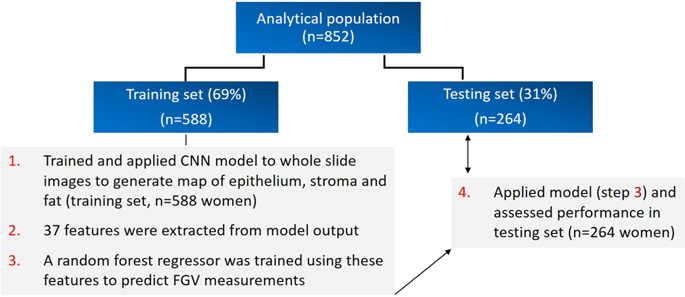npj Breast Cancer ( IF 5.9 ) Pub Date : 2019-11-19 , DOI: 10.1038/s41523-019-0134-6 Maeve Mullooly 1, 2 , Babak Ehteshami Bejnordi 3, 4 , Ruth M Pfeiffer 2 , Shaoqi Fan 2 , Maya Palakal 2 , Manila Hada 2 , Pamela M Vacek 5 , Donald L Weaver 5 , John A Shepherd 6, 7 , Bo Fan 6 , Amir Pasha Mahmoudzadeh 6 , Jeff Wang 8 , Serghei Malkov 6 , Jason M Johnson 9 , Sally D Herschorn 5 , Brian L Sprague 5 , Stephen Hewitt 10 , Louise A Brinton 2 , Nico Karssemeijer 3 , Jeroen van der Laak 3 , Andrew Beck 4 , Mark E Sherman 11 , Gretchen L Gierach 2

|
Breast density, a breast cancer risk factor, is a radiologic feature that reflects fibroglandular tissue content relative to breast area or volume. Its histology is incompletely characterized. Here we use deep learning approaches to identify histologic correlates in radiologically-guided biopsies that may underlie breast density and distinguish cancer among women with elevated and low density. We evaluated hematoxylin and eosin (H&E)-stained digitized images from image-guided breast biopsies (n = 852 patients). Breast density was assessed as global and localized fibroglandular volume (%). A convolutional neural network characterized H&E composition. In total 37 features were extracted from the network output, describing tissue quantities and morphological structure. A random forest regression model was trained to identify correlates most predictive of fibroglandular volume (n = 588). Correlations between predicted and radiologically quantified fibroglandular volume were assessed in 264 independent patients. A second random forest classifier was trained to predict diagnosis (invasive vs. benign); performance was assessed using area under receiver-operating characteristics curves (AUC). Using extracted features, regression models predicted global (r = 0.94) and localized (r = 0.93) fibroglandular volume, with fat and non-fatty stromal content representing the strongest correlates, followed by epithelial organization rather than quantity. For predicting cancer among high and low fibroglandular volume, the classifier achieved AUCs of 0.92 and 0.84, respectively, with epithelial organizational features ranking most important. These results suggest non-fatty stroma, fat tissue quantities and epithelial region organization predict fibroglandular volume. The model holds promise for identifying histological correlates of cancer risk in patients with high and low density and warrants further evaluation.
中文翻译:

卷积神经网络在乳腺活检中的应用,以描绘乳房X线照相乳腺密度的组织相关性
乳腺密度是乳腺癌的危险因素,是一种放射学特征,反映纤维腺组织含量相对于乳腺面积或体积的情况。其组织学特征不完全。在这里,我们使用深度学习方法来识别放射引导活检中可能与乳腺密度相关的组织学相关性,并区分高密度和低密度女性中的癌症。我们评估了图像引导乳腺活检中苏木精和伊红 (H&E) 染色的数字化图像(n = 852 名患者)。乳腺密度评估为整体和局部纤维腺体体积(%)。卷积神经网络表征了 H&E 组成。从网络输出中总共提取了 37 个特征,描述组织数量和形态结构。训练随机森林回归模型来识别最能预测纤维腺体体积的相关因素 ( n = 588)。在 264 名独立患者中评估了预测纤维腺体积与放射学量化纤维腺体积之间的相关性。第二个随机森林分类器经过训练来预测诊断(侵入性与良性);使用接受者操作特征曲线下面积(AUC)评估性能。使用提取的特征,回归模型预测全局(r = 0.94)和局部(r = 0.93)纤维腺体积,其中脂肪和非脂肪基质含量代表最强的相关性,其次是上皮组织而不是数量。为了预测高纤维腺体体积和低纤维腺体体积的癌症,分类器的 AUC 分别为 0.92 和 0.84,其中上皮组织特征最为重要。这些结果表明非脂肪基质、脂肪组织数量和上皮区域组织可预测纤维腺体体积。该模型有望识别高密度和低密度患者癌症风险的组织学相关性,并值得进一步评估。


























 京公网安备 11010802027423号
京公网安备 11010802027423号